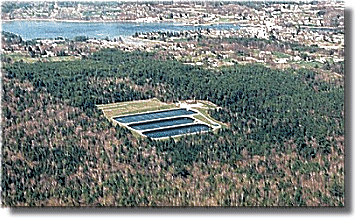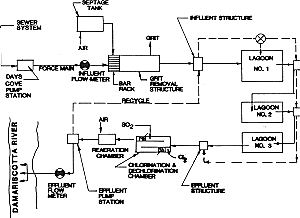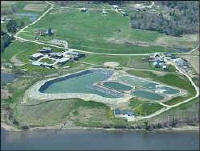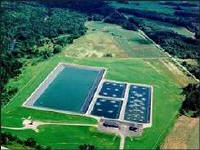Great Salt Bay Sanitary District

Protecting
our water resources is an important task that affects all of us. The
Damariscotta River, located in mid-coastal Maine, drains Damariscotta
Lake and Great Salt Bay. Damariscotta Lake is renowned for its eagles'
nest, while Great Salt Bay is one of the state's most productive
shellfish, alewife, striped bass and smelt fisheries. In 1988, working
closely with State and Federal agencies, the Great Salt Say Sanitary
District completed the construction of new wastewater collection and
treatment facilities to serve the communities of Damariscotta and
Newcastle and to restore and preserve the water quality and valuable
fisheries of the Great Salt Bay area.
Prior to the
construction of the new wastewater collection and treatment
facilities, untreated sewage from the Towns of Damariscotta and
Newcastle flowed to the river, causing closure of the
highly-productive clam flats. As a result of the project, the
harvesting closure line will likely be relocated, thus allowing a
larger clam harvest.
The
Damariscotta-Newcastle collection facilities consist of 3.8 miles of
gravity sewers, three submersible pump stations, a cast-in-place
dry-pit pump station and 1.2 miles of force main. Due to the concerns
of residents, the Damariscotta- Newcastle treatment facility was
located away from the waterfront in a wooded area located more than a
half mile from the nearest residence. The treatment facility consists
of septage pretreatment, grit removal and biological treatment within
three synthetically-lined diffused aeration lagoons which encompass
six acres and total 10.5 million gallons. The treated wastewater is
disinfected with chlorine, dechlorinated with sulfur dioxide,
reaerated and discharged via an effluent/recirculation pump station
through a 1.2 mile effluent sewer and an outfall located adjacent to
the municipal parking lot boat launch. The outfall location was
selected for its cost-effectiveness and minimal impact to anadromous
fish runs. This facility is the first municipal wastewater treatment
plant in Maine to utilize chlorination-dechlorination as a means of
controlling the discharge of chlorinated effluent to receiving waters.
The system represents another example of Wright-Pierce's continual
efforts to provide cost-effective innovative solutions to the
increasingly complex problems of wastewater treatment.
BASIC DESIGN DATA
| Design
Flow: |
.268
MGD |
| Total
Lagoon Volume: |
10.5
MG |
|
Design Detention Time: |
32.6
Days |
|
Construction Cost |
4.87
Million |
|
Funding: |
EPA/DEP: 95.7%
Local: 4.25% |
Lagoon
Specifications
|
Lagoons |
No.1 |
No.2 |
No. 3 |
|
Volume |
4.0 MG |
2.0 MG |
2.0 MG |
|
Aeration |
Fine
Bubble |
Fine
Bubble |
Fine
Bubble |
Comments:
Facility has (4) 25 horsepower blowers. One unit is
operated inthe winter while two are operated during the
summer months.
System Information
|
Design Flow |
0.268 MGD |
|
Actual Flow |
0.130
MGD |
|
Discharge To |
Damariscotta River |
|
Year Built |
1987 |
|
Design Engineers |
Wright-Pierce |
|
Septage Received |
No,
has septage receiving station |
|
Collector System |
9
miles of gravity, 4 submersible type pump stations that feed to
one large wetwell/drywell pump station which then pumps to the
plant. |
|
Staff Size |
Five
Full Time |
|
Number of Users |
1,000
Services |
|
Comments |
Effluent is pumped from the plant 1 1/2 miles to the river. |
Flow Schematic

CONTRACTORS
Brescia Construction, Inc. Caribou, Maine
Harry C. Crooker & Sons, Inc. Brunswick, Maine
Back to Lagoons in
Maine

